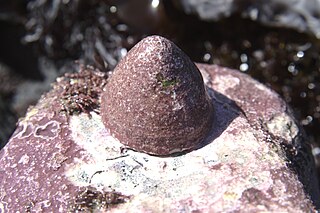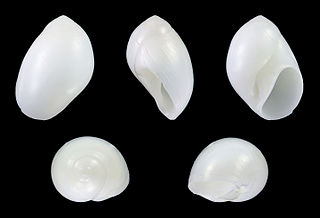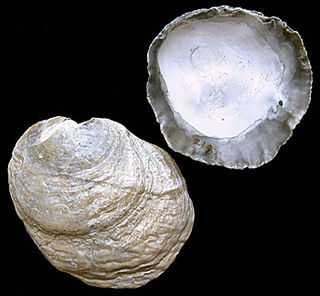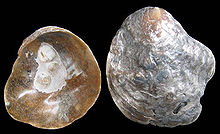
Helix is a genus of large, air-breathing land snails native to Europe and the Mediterranean region. They are the type genus of the family Helicidae and among the first animal genera described by Carl Linnaeus. Members of the genus first appeared during the Oligocene. Like most land snails, Helix species are hermaphroditic, and like other helicids a courting pair will impale each other with hormone-rich love darts prior to exchanging sperm. Well-known species include Helix pomatia and Helix lucorum. Cornu aspersum – another well-known helicid – was originally described as a member of Helix, but the prevailing classification places it as the sole member of the sister genus Cornu.

Bulla is a genus of medium to large hermaphrodite sea snails, shelled marine opisthobranch gastropod molluscs. These herbivorous snails are in the suborder Cephalaspidea, headshield slugs, and the order Opisthobranchia.

Littorina is a genus of small sea snails, marine gastropod molluscs in the family Littorinidae, the winkles or periwinkles.

Ostrea is a genus of edible oysters, marine bivalve mollusks in the family Ostreidae, the oysters.

Thais, sometimes known by the common names dog winkles or rock shells, is a genus of medium to large predatory sea snails with an operculum, marine gastropod mollusks in the family Muricidae.

Acmaea is a genus of sea snails, specifically true limpets, marine gastropod mollusks in the family Acmaeidae, one of the families of true limpets.

Polinices is a genus of predatory sea snails, marine gastropod molluscs in the family Naticidae, commonly known as moon snails.

Natica is a genus of small to medium-sized predatory sea snails, marine gastropods in the family Naticidae, the moon snails. The genus was erected by Giovanni Antonio Scopoli in 1777.

Pododesmus macrochisma, common name the green falsejingle or the Alaska jingle, is a species of saltwater clam, a marine bivalve mollusc in the family Anomiidae, the jingle shells.

Cymatium is a genus of small to large predatory sea snails, marine gastropod mollusks in the family Cymatiidae.

Patella is a genus of sea snails with gills, typical true limpets, marine gastropod mollusks in the family Patellidae, the true limpets.

Fissurella is a genus of small to medium-sized sea snails or limpets, marine gastropod mollusks in the subfamily Fissurellinae of the family Fissurellidae, the keyhole limpets.

Anomia is a genus of saltwater clams, marine bivalve mollusks in the family Anomiidae. They are commonly known as jingle shells because when a handful of them are shaken they make a jingling sound, though some are also known as saddle oysters.

Calyptraea, commonly known as the Chinese hat snails is a genus of sea snails, marine gastropod mollusks in the family Calyptraeidae, a family which contains the slipper snails or slipper limpets, cup-and-saucer snails, and Chinese hat snails.

Anomia simplex, the common jingle shell, is a typical species of bivalve mollusc in the family of Anomiidae, sharing attributes to blue mussels, American oysters, and bay scallops. Species related to the family of Anomiidae are often noted for their extremely thin, often translucent, paper-like shells. Anomia simplexcan be found in shallow waters, typically estuaries, mainly along the Atlantic Coast of North America; however, they can range from as far north as the coast of Nova Scotia, and as far south as the coast of Brazil.

Pododesmus patelliformis, the ribbed saddle-oyster, is a species of bivalve mollusc in the family Anomiidae. It is found in the north east Atlantic Ocean.
Enigmonia is a genus of saltwater clams, a marine bivalve mollusc in the family Anomiidae, the jingle shells. Enigmonia aenigmatica, the mangrove jingle shell clam, is the only species in this monotypic genus. It is found living on mangroves in the Indo-Pacific Ocean.

Codakia is a genus of saltwater clams, marine bivalve molluscs in the family Lucinidae.

















